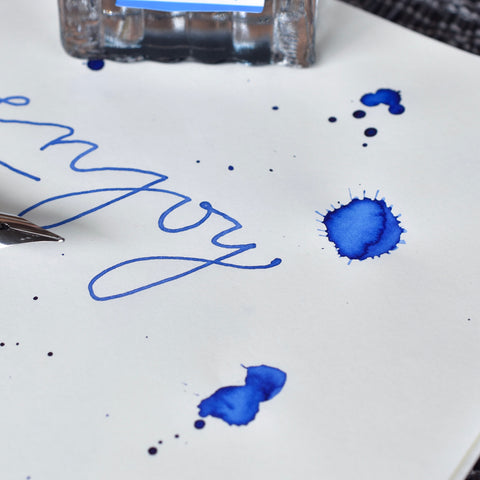You’ve heard of pairing the right wine to the right cheese?
As a man who sticks to a strict coffee-only diet, I know absolutely nothing about this.
But apply the same principles to fountain pens and paper, and that’s when some truly magical things can happen!
Have you ever seen a vibrantly sheening ink on Instagram, and then been disappointed that yours doesn’t look the same?
Standard copy paper, or paper from a standard notebook found at the dollar store will run about $0.01 per sheet. A good fountain pen paper will usually cost over $.25 per sheet.
That is quite a step up, but hopefully, I can share the somewhat limited knowledge I have gained in the last few months on why the paper is so important.

Created With JINHAO Blue Ink - $9.95
White vs. Cream
A lot of fountain pen users jump immediately into white paper, but for a little more elegant look, you can also choose a cream color.
I believe that the brighter the white, the truer the color of your ink will show. I usually stick with cream for my own personal preference, just because it’s a softer tone, and gives a more refined feeling to my own writing.
Feathering and Bleed-through
One of the most frustrating issues that we come across is feathering – that’s when ink seeps into the fibers of a sheet of paper, and the words sort of spread out.
This can cause smaller letters to mesh together and become hard to read. Another common issue is bleed-through.
This is when the fibers of the paper are too thin, and the ink actually bleeds through to the other side. If the ink doesn’t come through, but if you can still see traces of what you have written, this is called show-through.
Of course the thicker the paper, the less likely you are to have any evidence of your writings on the backside of the page.
Smooth vs. Gritty
You might think that the smoother the paper, the more comfortable the writing experience.
This is partly true, but smooth paper can be less absorbent.
This can cause slower dry times. If you are left handed, you will definitely want to find something that dries quickly.
A rougher texture is usually more absorbent, so this may be the route for you. Most right-handed people weigh the pros and cons of each, and eventually choose a spot somewhere in the middle, between smooth and gritty.
Why Won’t My Ink Sheen?
I fell into this same trap with my first attempts at getting ink to sheen.
I was unaware of just how important a role the paper was playing. Sheen is when color, other than the advertised color, is present on the outer edges of the ink, after it has dried.
So this could be blue ink that turns red around the edges.
This can be very hard to see, so the first thing to do is to go outside, or use a high-powered light to be sure that you don’t miss the beauty of this phenomenon.
Sheen typically occurs after ink has dried.
The longer it takes to dry, the better the sheen. So if you want to see the array of beautiful colors in your new ink, be sure to choose a smoother paper that has a longer drying time.
Be sure to use a pen that writes pretty wet so that you can really saturate the sheet with that liquid gold.

JINHAO 30ml Violet Ink Bottle - $9.95
Personal Favorites
Admittedly, I haven’t had a chance to try too many of the great brands out there; however, my favorite so far is Tomoe River.
The thinness of the paper is unbelievable, considering the lack of any feathering, and no bleed-through. There is a little show-through, which is understandable with how thin each sheet is.
The dry time is a little slow, though, so you can get some brilliant sheen from your inks. If you were looking for quicker drying time, especially if you’re a lefty, I would recommend paper from Rhodia.
These sheets are thicker, so there is less show-through. Whichever you decide, it's important to remember the importance of the paper you use!









Oh my! These are some excellent tips! I’ve been reading articles on here for days and although I have a fairly solid grasp on the world of stylophilia, I am digesting oodles of tips as of late! I look forward to reading more — a lot more! Keep up the outstanding work, this site is quite the resource!
Thank you for the good tips and the good reminders. I am a lefthanded overwriter and run into some real issues regarding slow drying times on some of those smoother, “better” types of paper. For me, prompt absorbency is really important, regardless of the price tag. I have come to realize that the pen, paper and ink all have to work together as a team.
Leave a comment